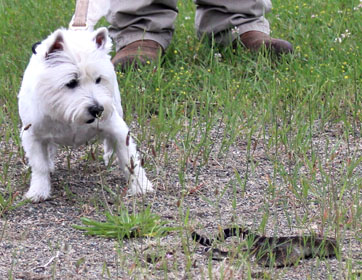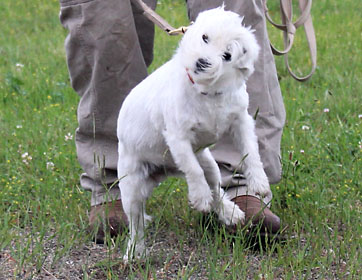home | internet service | web design | business directory | bulletin board | advertise | events calendar | contact | weather | cams

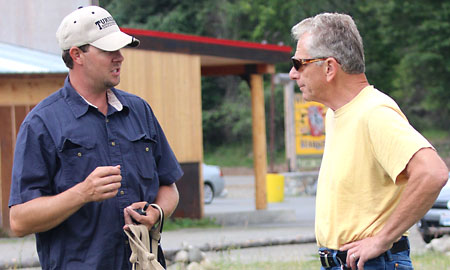 Trainer Eric Briggs, left, explains to Sandy Liman what's going to happen to his West Highland terrier, Bubba. Trainer Eric Briggs, left, explains to Sandy Liman what's going to happen to his West Highland terrier, Bubba.
Rattle and Jump Fifty-four dogs whose owners want to protect them from rattlesnake bites underwent snake-aversion training by a visiting California company, Natural Solutions, Saturday in Winthrop. Trainers were teaching dogs to recognize the smell and sound of the Northern Pacific rattler, the only rattlesnake that lives in Washington, according to the seven year-old firm’s owner, Erick Briggs. Because it’s illegal for anyone in Washington to own rattlesnakes, his company was required to obtain a temporary permit from the state to bring the snakes here, he said. The event was sponsored by the Methow Valley Veterinary Clinic and Hospital and held in the field behind the clinic. Heather Marrone, who with her husband, Michael, operates the clinic, told Grist, “We felt there was a need for it. We plan to make it an annual event here.” It’s the second year the firm has held the training in the valley. 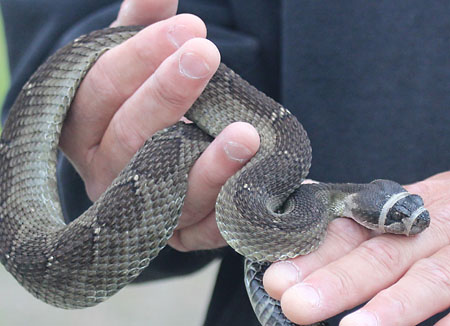 A Northern Pacific Rattlesnake (the only rattler found in Washington state) used at the training. The tape around its mouth allowed the snake to stick out its tongue but not to open its jaws. A Northern Pacific Rattlesnake (the only rattler found in Washington state) used at the training. The tape around its mouth allowed the snake to stick out its tongue but not to open its jaws.
The clinic still recommends dogs have snake venom vaccinations, Marrone said. But, she added: “This is way better” because it teaches dogs to avoid snakes in the first place. Briggs and trainer Anthony Harper put the dogs through their paces starting with exposure to baby rattlers. After the dogs were fitted with electronic collars, they were brought nearly face to face with baby rattlers. When they engaged with the snakes, they got a quick zap from the trainer. Next they were exposed to a snakeskin lying in the grass. Dogs that showed they remembered the smell - and the electronic jolt - avoided the skin and didn’t get another electronic reminder. Dogs whose indifferent behavior showed they hadn’t made the connection that the smell of the skin represents something dangerous got another jolt. The third step was to teach the dogs to recognize the sound of a rattler. At that training station, a zap is mandatory for all dogs as soon as they hear the sound of the snake, said Briggs. The last step was to bring the dogs near a large muzzled rattler handled by Joel Almquist, who owns an animal sanctuary in Phelan, Ca. Dogs that showed they associated the snake smell with pain and chose to avoid the rattlers escaped a jolt. Those that showed they hadn’t quite mastered the connection got an electronic reminder. 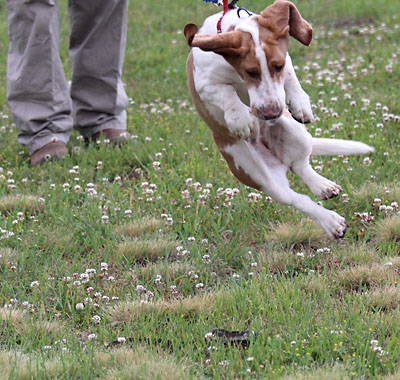 Jools, an 8 - and one-half month-old Basset hound belonging to Susie Kowalczyk and Kay Lee of Twisp, learns what to do when meeting a rattlesnake. Jools, an 8 - and one-half month-old Basset hound belonging to Susie Kowalczyk and Kay Lee of Twisp, learns what to do when meeting a rattlesnake.
A final test was for the owners to call their dogs to come while the rattler was lying on the grass between them. The dogs typically refused to come anywhere near the rattler but ran in wide circles away from the snake to get back to their owners. Many of the dogs also refused to look at the snake after they’d been zapped. The point is to make the dogs think that the snake is the source of the pain they feel, said Briggs. But the dogs have to be fully engaged with the snakes before the electronic “correction” is applied, he explained. Otherwise, he added, “It’s just punishment.” The shocks give the animals momentary muscle cramps, according to Briggs. “Don’t be afraid to lay it on her. We’ve got snakes,” dog owner Don Dayment of Carlton urged the trainers when it was his dog Bella’s turn. “You can lay it on her. I’d rather have her alive.” One of his dogs was bitten recently up Gold Creek, he said. She had been vaccinated, he added, and the vet told him that helped her survive. Dog owners at the event said they hoped the training would help keep their dogs safe. Therese Ohlson of Twisp, owner of 10-year-old Emma, “a dumpster dog from the streets of Wenatchee,” said she brought Emma to the training because she rides horses and the dog “almost got bit by a baby rattler last spring.” Sandy Liman of Twisp, a hiker, said he brought Bubba because he wants to do whatever he can to keep her safe. And because she may now be aware of snakes before her humans are, “She’ll make us safe, too.” The trainers told dog owners that for the training to be most effective, their dogs should go through the sessions once a year for the next three to four years to be sure the unpleasant association is remembered. Cost of the session, which lasts some 10 to 15 minutes per dog, is $75.
6/24/2012 Comments Solveig's always fine writing was a long needed piece and Grist did a huge public service publishing it. I did not go because my dog is deaf and virtually blind---I was too dumb to consider the scent. Next year . . .Thanks. Bob Spiwak Mazama
|
